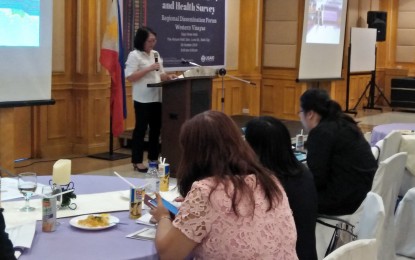
ILOILO CITY — The Center for Health Development (CHD) in Western Visayas has admitted the need to double their efforts to address the high rate of childhood mortality in the region.
Results of the 2017 National Demographic and Health Survey (NDHS), conducted by the Philippine Statistics Authority (PSA), showed that 31 percent of 1,000 pregnancies of at least seven months duration are stillbirth; 33 percent of 1,000 live births do not reach their first month of life; 38 percent die before their first birthday; and 46 percent of children die before reaching their fifth birthday.
The result is higher than the national childhood mortality rate, which is 22 percent for under-five mortality, 21 percent for infant, and 14 percent for neonatal mortality.
Neonatal mortality refers to children who die before their 28th day while infant mortality refers to those who die before they reach one year old.
The result was presented to stakeholders during a regional dissemination forum held in a hotel here early this week.
The figure placed Western Visayas among the top three regions in the country with highest under-five mortality, CHD Regional Director Marlyn W. Convocar said in an interview. “We should not settle for that result. We should do something about that in the region,” she added.
Convocar said they reviewed common causes of death for neonatal, infant and under-five children in the region and these are pneumonia, prematurity, and septicemia.
These showed that health practitioners should be on alert each time an under-five child with cough, fever and colds, which could lead to pneumonia, seeks consultation in their health facility, she said.
“We should give extra care and follow up for these children because most of them will die. This is really a wakeup call,” she said.
She cited that 46 percent data is a far-cry from the data that they gathered where only 13 percent of every 1,000 live births die before reaching five years old.
Convocar added that the discrepancy could be explained such that not all mothers sought consultation in government health facilities when the survey was conducted. Some have private physicians and cases of deaths are not reported to the Department of Health (DOH).
She said she will require all health workers to be very vigilant in cases of children suffering from pneumonia.
“We should equip our people with training, provide medicine, equipment and appropriate facility to respond to the needs of patients,” she added.
She said since the diseases are preventable, parents should not wait for the disease to worsen before bringing their sick children to health facilities.
“Services at health centers are free so I am urging parents to bring their sick children for early consultation. Give them nutritious foods, observe proper hygiene. All of these should start in our households,” she said.
Meanwhile, PSA 6 (Western Visayas) Director Fred Sollesta said the NDHS 2017 was the sixth in a series of surveys conducted in the country. The last survey was undertaken in 2013.
“Results from our NDHS are among the mechanisms to provide data for monitoring and evaluating health programs, both at the national and local levels,” Sollesta said as he urged the public to study the “report and read every single word of it.”
The survey report is more than 400 pages, he said.
The respondents were 27, 496 households and 25,074 women aged 15 years to 49 years old nationwide. (Perla Lena/PNA)
